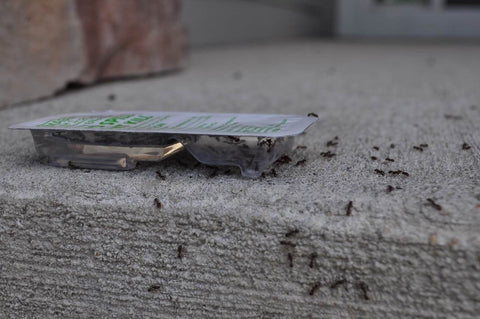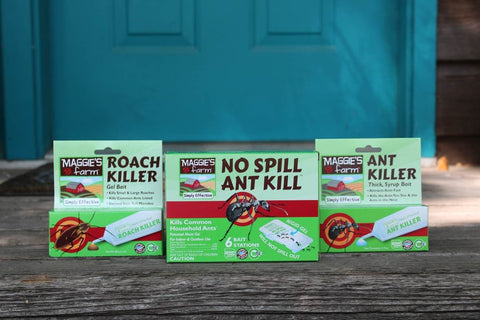Ants can be some of the toughest pests to control because of the size of their colonies and the difficulty of finding their nests. The best way to control an ant problem is to get rid of the source—the colony. This task can be accomplished with an ant bait. We’ve gathered information about ant baits to help you successfully keep these pests away.
Ant Baits vs. Insecticide Sprays
When spotting ants in your home, your first thought may be to grab an insecticide spray. Plant-based insecticide sprays are effective at eliminating the ants you see. However, if a colony is hidden nearby, ants will keep showing up. Ants use pheromones to lead other ants to the food source they discovered. This means ants will just keep coming…and coming. Baits are designed to attract ants. They eat the bait and carry some of it back to the nest to share with other members of the colony. This helps to eliminate the source of the infestation.
Tips for Using an Ant Bait

Baiting is the best way to get rid of an ant problem, but it can be challenging. Check out a few tips for using ant baits.
- Remove Other Food Sources: Ants will eat many things including your crumbs. Remove the food source that first attracted the ants. This will allow the food attractant in the bait to become their primary food preference.
- Use the Bait Stations & Bait Placements Properly: Always place ant baits next to the ant trail to make it easier for the foraging ants to find it. Never use an insecticide spray with repellent properties around baits. The foraging ants need to get to the bait to take it back to the colony. If they are repelled by the spray, they won't make it to the bait.
- Use Multiple Bait Placements: Several bait placements are better than one. It enhances an ant’s attraction to the bait, and it increases the number of foraging ants taking the bait. Just remember to check the bait placements frequently and replace when necessary.
- Place Bait Outside: Indoor ant problems begin outside. Be proactive and place ant baits around the perimeter of your house where you see ant activity. This will help prevent foraging ants from getting inside your home in the first place.
- Use the Right Bait: An ant’s food preference can differ depending on the time of year or the needs of the colony. Knowing when to use a sugar or protein-based bait is important.
How to Choose an Ant Bait

Ants will usually eat anything, but their food preferences change throughout the year. Sugar is the number one food attractant of ants. It’s found in most ant baits on the market. However, in spring and early summer, many ant species are searching for protein to feed to their developing colonies. You’ll have to determine the food preference of the ant species that’s invading your home. Here are three steps to help you figure this out.
- Put dabs of peanut butter (protein) and jelly or honey (sugar) on an index card.
- Place them close to the ant trail to see which one attracts the ants.
- Based on those results, use an ant bait that has either a protein or a sugar attractant.
How to Know if an Ant Bait is Working

When ants invade your home, it’s important to know that your solution is working. Check out how you can tell if the ant bait is helping.
- Ants Show Up: This may seem counterintuitive, but you want the bait to attract ants. They should start showing up shortly after the bait is placed. If many foraging ants eat the bait, then more bait will be delivered to the colony.
- Ant Numbers Begin to Decrease: You will start seeing fewer ants around the bait. This is a sign that it’s killing the colony. It could take a couple days up to a week before you notice the number of ants dwindling. The larger the colony, the longer it will take.
- Ants Disappear: When you no longer see any ants, it means the colony has been eliminated.

Which Maggie’s Farm Ant Bait Should I Use?

Maggie’s Farm has three baits that can help you keep your home free of ants. Our No Spill Ant Kill and Ant Killer Bait are sugar-based baits with boric acid as the active ingredient. Our Roach Killer Gel Bait is a protein-based bait. This bait’s active ingredient is abamectin, which is derived from soil microbes. It can also help to get rid of cockroaches and silverfish.
Dealing with an ant infestation can be challenging. Using the correct bait and placing it in the right places will help make your ant baiting efforts successful. If ants and other pests are bugging you, we have your back! For a more environmentally and family-friendly solution, check out our Maggie’s Farm Simply Effective™ Pest Control products.
